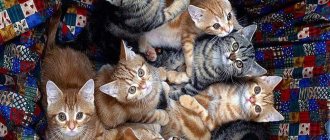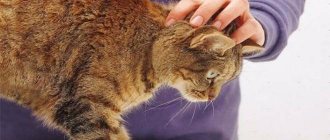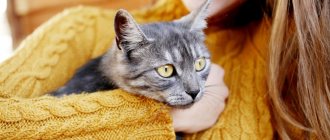The most dangerous cats in the world: characteristics
The love for exotic, rare pets, the desire to impress guests with an unusual animal living in the house has led to people getting cats that are completely unsuitable for apartment keeping.
The action leads to inconvenience. Wild animals spoil the design of housing, avoid people, get sick, experience chronic stress, and some representatives are quite dangerous for the owner and his family.
Savannah
Cats seem to have stepped out of ancient Egyptian frescoes: graceful flexible body, long legs and neck, small head, pointed ears.
The thick, short, spotted coat makes the cat look like a miniature version of a leopard. Savannahs tend to show a sharp character, wild habits, and aggressiveness. They may perceive strangers and other animals as objects of hunting. They can only be walked on a leash.
Abyssinians
The breed is suitable for people who are not ready to constantly communicate with their pet and do not expect excessive affection from it. The Abyssinian will take care of herself very well, prefers solitude, does not like to be cuddled, forced to play, and hides on closets and other high places in the apartment.
She has a developed intellect, is capable of learning to walk on a leash, fetch, and other commands, but tends to be quick-tempered.
Playing with her is fraught with scratches and bites. Having been punished, she is offended and vindictive. She is inquisitive, active, and if she picks up the key to her prickly character, she gets a devoted friend.
Manul
A wild cat does not live well in captivity. Kittens taken into the home, even with constant contact with people, remain wild, strive for solitude, and hide in secluded places.
An adult animal looks brutal, resembling a lynx. It reaches a height of 65 cm, weight up to 5 kg, but due to its thick, long, lush fur it gives the impression of being “robust”. Even in zoos, breeding Pallas' cats is rarely successful; most of the offspring die.
Be sure to read:
A cat’s teeth: diagram, how many depending on age, main diseases
Long claws, sharp fangs, agility, physical strength, which help Pallas’ cat to survive in the wild, will cause a lot of trouble for the owner. The animal does not need the company of its relatives, does not like children or other pets living in the house. Can perceive a domestic cat or a small breed dog as game.
Siberian cats
Fluffy, handsome dogs with thick long hair, powerful paws, large muzzle and body. The weight of an adult cat is about 6 kg, and that of a male cat is 12 kg. The character corresponds to the name of the breed.
Loyal and devoted to their owner and his family, animals are full of inner dignity, do not tolerate familiarity from strangers, and will not allow themselves to be offended. They are friendly towards other animals and lenient towards children.
They are amenable to training, quickly adapt to the rules established for them, but in some moments they can be strictly principled. They need free space, personal territory, the opportunity to show natural instincts, and hunt.
Bengal cats
From early childhood, Bengal kittens need their owner's love, attention, and a warm atmosphere. Very mobile, active, they retain the desire to play and hunt until old age. They can climb curtains, damage furniture, without being able to splash out energy in a peaceful direction.
You can’t shout at them, much less hit them. Grievances are remembered for a long time. The character of the Bengal breed is explosive, impulsive, and prone to revenge. Breeders know many cases of a pet attacking its owner, affecting the cat's pride.
The Bengal breed should be raised patiently, using affection, kindness, taking into account the animal’s independence of character and love of freedom.
Jungle cats
A large breed, the weight of an adult reaches 15 kg. Jungle cats are not completely domesticated, even when raised in a human family from a young age. They do not like to be touched or stroked; they prefer to spend time alone, minding their own business.
It rests during the day and is active at night. Keeping a predator in an apartment is a dubious undertaking; it will happily jump around, demolishing vases and decorative items along the way, use curtains to climb higher, and repeatedly sharpen its claws on furniture, leaving deep marks on the upholstery.
If you really want to have a pet with the appearance of a lynx, it is better to place it in a spacious enclosure.
Chausie
Chausie cat breed
This is a new breed of cat, bred by crossing a domestic Abyssinian cat with a wild jungle cat, and was registered in 1995. Breeders wanted to get a new breed that would retain the appearance of a wild cat, but have the character of a domestic cat. Externally, the Chausie is similar to a cougar; they have a powerful, slender body, much more powerful than that of most domestic cats. Cats of this breed are ready to hunt around the clock. Families who dare to adopt a Chausie kitten are subject to strict requirements, given the aggressiveness of these animals. People should, from childhood, prevent any attempts to play dangerous games with chausies. Otherwise, this breed can be called very inquisitive and even kind. This breed is characterized by a balanced temperament, developed intelligence and self-esteem. You should not have chausie in small city apartments, as they need a lot of space. They do not strive for privacy; on the contrary, they try to attract the attention of any person. They need regular training, especially since they love heights, which can damage some fragile household items that are best removed in advance.
Aggressive cat breeds: features, how to influence
Some domestic cats have a naturally explosive temperament; before choosing a specific breed, you need to familiarize yourself with its character and understand whether it matches the conditions in which the future pet will live.
Be sure to read:
The cat has dilated pupils: physiological and pathological reasons, when to sound the alarm, treatment
If there are children in the family who will be allowed to constantly cuddle and stroke an animal that has a love of independence, personal space, you should not scold him later for scratches and bites, left in the arms of a son or daughter.
Persian cat
The look and expression of the Persian's muzzle evokes thoughts of a complex, unvarnished character. The breed standard states that purebred specimens must be calm, balanced, and not show active aggression towards people and animals.
Cats are pride creatures; they are not leaders in a pack of people, but they do not assign themselves the place of “omega.” They choose the main owner, and the rest are condescendingly tolerated. It is not possible to influence the choice; the Persian will decide for himself who to give his love, purring, warmth.
The fluffy handsome man cannot live without human company; from long loneliness he begins to get sick and becomes sad. They get along well with children, as long as they do not turn the animal into a toy.
A Persian can show aggression in an extreme situation, defending himself from pain, intrusive attention that goes beyond the boundaries of common sense, and experiencing fear.
Ocicat
The breed received official registration in 1987 and is a derivative of a mixture of Siamese, Abyssinian and American Shorthair blood. The appearance of Ocicats is colorful, reminiscent of wild cats. Personality: sociable, inquisitive, friendly.
Pets are “talkative” and express the entire range of emotions with their voices. Not receiving enough attention to the person, they begin to sing, meow, influencing the owner in every way, reminding them of themselves. They have a tenacious memory, a remarkable mind, and quickly figure out how to open a refrigerator or closet door. They are easy to teach funny tricks. They are playful, active, aggression is not a characteristic feeling for them.
Turkish Angora
The most delicate snow-white cloud with huge eyes - this is how you can describe these stunningly beautiful cats. Their fur is silky, delicate, flowing between the fingers like silk, does not require special care, and is not prone to tangles.
At the end of the last century, individuals were selected for breeding solely on the basis of external characteristics, paying little attention to character. Often at exhibitions, Angora cats hissed at strangers and could scratch or bite an expert who picked them up.
Hence the assertion that the breed belongs to the aggressive ones was born. Over time, breeders paid more attention to issues of character when mating, and today beautiful cats of purebred lines have a pleasant sociable nature, love affection, and are willing to make contact with humans.
Ukrainian Levkoy
The only breed bred in Ukraine, it was formed from the love of the Don Sphynxes and the British Fold. The exotic combination of a naked body and small pendulous ears captivated visitors to the exhibition, where the Levkoy was first shown in 2005.
Be sure to read:
How much does a cat weigh: table by age and breed, assessment, deficiency, norm and excess
They got their name due to the similarity of the structure of the ears with the flower of the same name.
Hairless Ukrainian cats, despite their spectacular appearance, are simple in their maintenance and not whimsical. They have an extreme degree of curiosity and will not miss a single, even the most insignificant event in the house.
They have a balanced temperament, get along well with children and other pets, and show interest in guests.
The main gentleman is loved to the point of unconsciousness, following on his heels; the rest of the family members are also not deprived of attention and affection. Levkoys are not at all vindictive; aggression can manifest itself in extreme situations or in the kitten’s puberty, but usually does not go beyond limits.
Siamese cat
The statement about the viciousness of the Siamese is partly true. The character of these cats is picky and complex. An animal can completely love its owner, but also become disappointed in him when faced with rudeness or the use of physical or moral violence.
In this case, a small but proud animal will really take revenge with all the cat’s strength, shitting in slippers, spoiling objects, and attacking openly.
Siamese have a hard time with loneliness, succumb to attacks of jealousy, are distrustful of strangers, and if a guest tries to get too close and too intense, they can resist.
Siamese cat
Siamese cat
These blue-eyed beauties with an unusual color are considered evil and vindictive. The reason for this is probably red burning eyes filled with blood and revenge. And this is partly true. They can remember an insult for a long time and take revenge at the most unexpected moment. You should not take them into a family with small children. They will not tolerate unnecessary affection and an abundance of attention. And the owner’s incorrect behavior will invariably lead to aggression and hissing. Siamese also will not allow themselves to be assaulted or neglected. But many people consider this opinion to be erroneous, and people continue to have these oriental beauties, who are incredibly loyal, love their owner very much and love to communicate and play with him. Siamese are cheerful, active, moderately playful and sociable. They love it when their owners talk to them and are sensitive to their mood.
Do not miss! The deepest river
Is it possible to turn aggressive cats into affectionate ones?
Some breeds, such as Pallas's cat, are not domesticated. A wild animal forced to live in captivity retains autonomy, avoids communication, and leads a genetically determined lifestyle. This must be taken for granted. A person can buy an exotic kitten, raise it, but still not receive any response.
Domestic cats with a hot temper can be trained. With a competent approach, understanding of the characteristics of the pet’s nervous system, patience and love of the owner, the animal’s disposition changes for the better.
Individuals who survived cruel treatment, abandoned by previous owners, or who lived on the street experienced severe trauma that influenced their character and behavior. They are difficult to make contact, distrustful, fearful, aggressive, but the kindness and warmth of the new family will sooner or later melt the ice, the cat will become tame and affectionate.
Have you ever encountered cat aggression, what caused it, and how did you overcome the difficulty? Share your experience in the comments to the article.
Jungle cats
Jungle cats came to us from the wild.
In appearance, they are more like a lynx and gain weight up to 15 kg. There are many exotic lovers who want to tame just such wild cats. Jungle cats are almost impossible to train, this is possible in the rarest cases, much more often they remain savages. In their character such opposite qualities as mobility and laziness coexist at the same time. You must always be careful when handling them. Jungle cats need active communication, otherwise they quickly start to run wild. But if you show them that you care every day, they will remain in a good mood. Being active hunters, jungle cats love to constantly play, climb somewhere, hunt, and not sit on the owner’s lap.
It is important to train them to relieve themselves in the litter box.
Reed cats treat other animals quite calmly. And if enough attention is paid to them, the inhabitants of the house can hope not to become the subject of their hunt. They have excellent hearing, so they are sensitive to the slightest noise, and their curiosity makes them immediately find out what is happening there. Unlike most cats, jungle cats love water and are willing to spend a lot of time in it.
Whoever finished reading, thank you very much, write in the comments: if you have a cat? What breed? Or maybe you have a cat and it’s on this top list? Good mood to you all
Cats are usually classified by breed. The characteristics that allow an animal to be classified as a particular species include not only its exterior features, but also its character. When you decide to get a cat, you should check whether it is one of the ten most dangerous cat breeds that exist today. First of all, this is recommended for families with children to prevent harmful pets from attacking their children. Which cat breeds are considered the most dangerous in the world?
Aggressive cats with a high degree of loyalty - Savannah
This breed is the largest hybrid among cats. This is a cross between a serval and a domestic cat. They are perceived as canine cats in terms of loyalty and devotion to their owner, and are quite large - weighing up to 15 kg. Keeping one of these cats as a pet is against the law in many countries.
Savannah cats are still available as F1 - which are considered too wild to be true domestic cats. Therefore, Savannahs are half domestic aggressive cats bred with the African Serval in 50% of its blood.
The F2 generation already has a lower percentage of Serval blood - 25%, so they are sold as domestic cats. According to some owners of the breed, these large cats are curious, playful and resemble dogs. Tolerant to children, they can be unpredictably aggressive towards other pets and mark their territory.
A large cat that must be on a leash when walking with it
Aggressive cats and our latest representative - Serval
Servals have the longest legs and the largest ears of any cat breed. They have a small head in relation to their body. It is not easy to keep a Serval as a pet, but it is possible. They only need to be kept in an enclosure, they have special dietary needs and a great need to hunt (the best hunters in the cat world).
You cannot hit or shout at your pet - they are vindictive and aggressive cats. And their size also makes them dangerous - they can easily hit or scratch. Therefore, families with children should abandon the idea of domesticating such a kitten.
This is a serval kitten
Maine Coon
Maine Coon breed
This is the largest breed of domestic cats. The Maine Coon has a massive body and wide chest, and usually weighs about 15 kg. But this breed gains weight quite quickly, which can lead to obesity. They are often bred as exotic cats. Maine Coons may not always be harmless; sometimes they can be aggressive.
And a larger cat can mean more serious injuries. If a stranger enters the territory of the house, the Maine Coon may meet him aggressively. But at the same time, breeders note their flexibility and high intelligence. Maine Coons can pick up on the intonations of their owners and respond to their requests.
READ Lifespan of British cats at home. How long do British cats live at home? Life expectancy of a cat after removal of a mammary tumor
They are very curious and therefore require close attention to themselves. They don’t like to be left alone, so if a Maine Coon needs to be left alone for a while, then you should provide it with toys, otherwise the owners will later regret leaving it. Maine Coons do not require special conditions to keep; they feel good in any climate. But during walks you should not leave them alone, as their mood can instantly change.
Manul
It is believed that Pallas cats are domestic cats and have nothing to do with “wild” cats. Actually this is not true. These are very independent and secretive cats that, in case of danger, can attack without hesitation. And the fangs and teeth of Pallas cats are much longer than those of an ordinary cat.
When choosing a purebred cat, first of all, think about whether its character suits you. Even if you come across a very kind breed, train and educate your pet so that in the future it does not show aggression.
https://zen.yandex.ru











